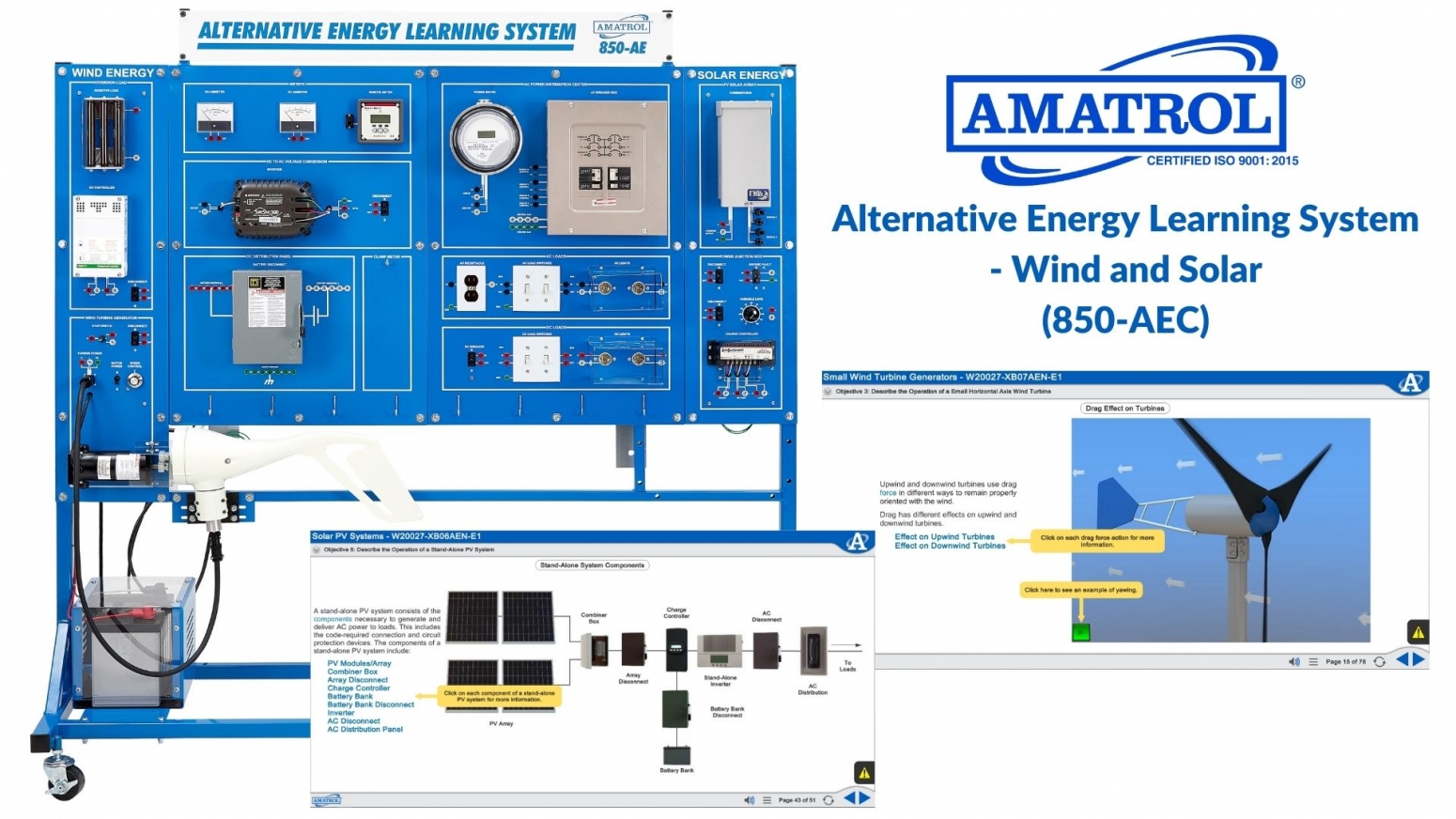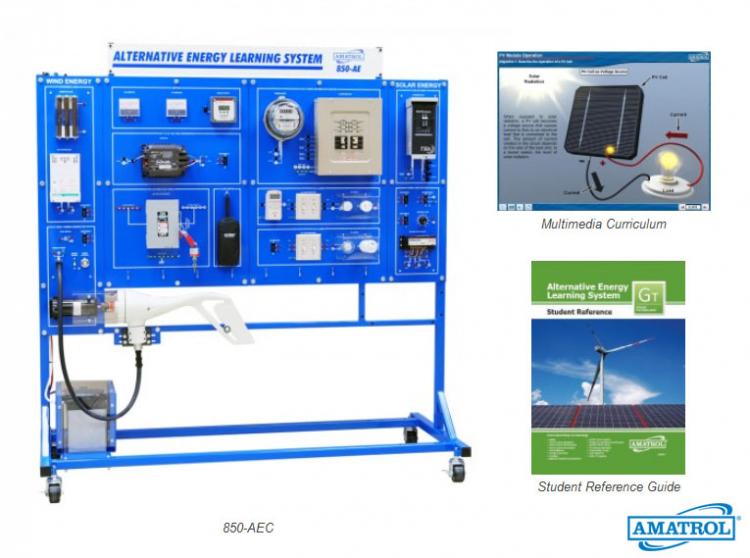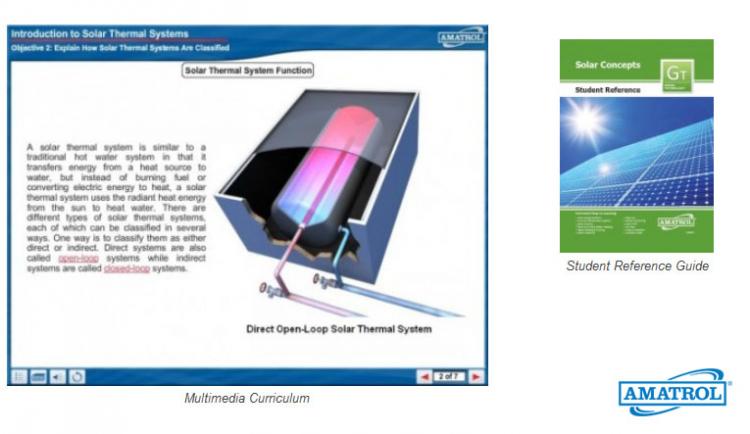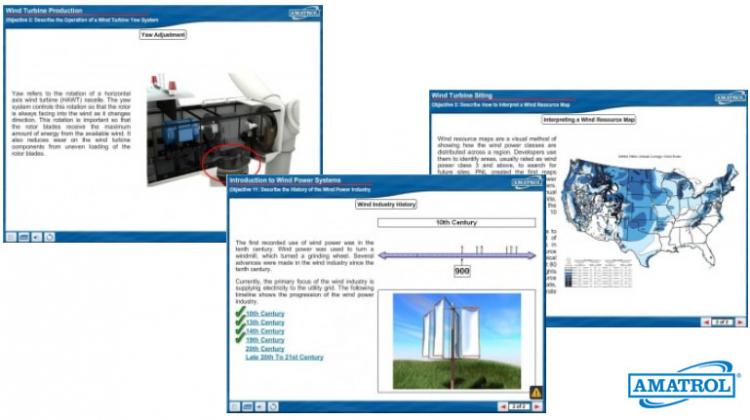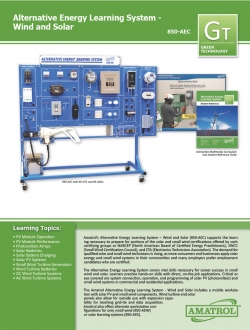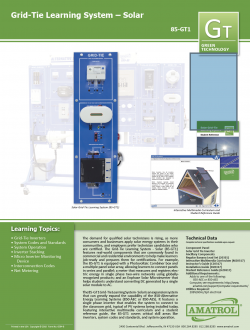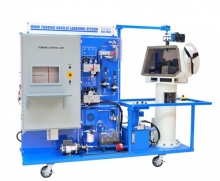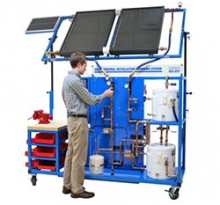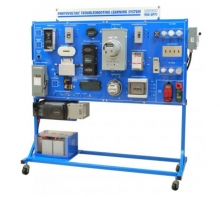Amatrol Alternative Energy Learning System
The demand for qualified solar and small wind technicians is rising, as more consumers and businesses apply solar energy and small wind systems in their communities. Many employers prefer employment candidates who are certified. Amatrol’s 850 series Alternative Energy Learning System supports the learning necessary to prepare for portions of the solar and small wind certifications offered by such certifying groups as NABCEP (North American Board of Certified Energy Practitioners), SWCC (Small Wind Certification Council), and ETA (Electronics Technicians Association).
The 850-AEC Alternative Energy Learning System teaches students key skills needed for job success in small wind and solar. Students will learn hands-on skills they can use on the job. Critical skill areas covered are system connection, operation, and programming of solar PV (photovoltaic) and small wind systems in commercial and residential applications.
The Amatrol Alternative Energy Learning System – Wind and Solar includes a mobile workstation with solar PV components, small wind components, multimedia student curriculum, and teacher’s assessment guide. The mobile workstation is equipped with pre-mounted components for easy inventory. Wind turbine and solar panels also allow for outside use with expansion capability for teaching grid-tie and data acquisition. Amatrol also offers alternate workstation configurations for either small wind or solar individually.
Multimedia CurriculumStudent Reference GuideProduct OptionsKey FeaturesLearning TopicsIndoor / Outdoor UseReal World ComponentsAlternative Energy CertificationsConvenient Indoor / Outdoor Use
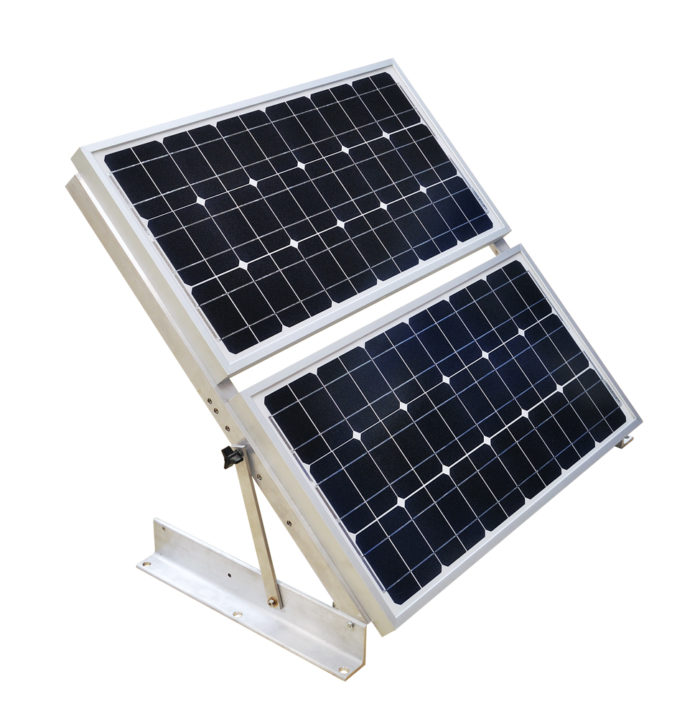 A common issue many instructors have when beginning an alternative energy training program is location. After all, don’t you need to be outside to teach solar energy and wind turbine technologies? Fortunately, the answer is no. With Amatrol’s 850-AEC trainer, alternative energy training can occur both indoors and outdoors.
A common issue many instructors have when beginning an alternative energy training program is location. After all, don’t you need to be outside to teach solar energy and wind turbine technologies? Fortunately, the answer is no. With Amatrol’s 850-AEC trainer, alternative energy training can occur both indoors and outdoors.
For example, the required Solar PV Array Station (85-SPA1) easily disconnects from the workstation to be used outdoors. Indoors, the solar panel array works in conjunction with the required Solar PV Sun Simulator – Alternative Energy (85-SPS1), which uses artificial lights to simulate sunlight. The 850-AEC can also be connected to client-supplied wind turbines or roof-top solar panels with the addition of optional interface connections.
Real World Components: Multiple Panel Array and Modern Communications
Real-world components commonly found in commercial and residential environments to help make learners job-ready are showcased in the 850-AEC. For example, the 850 is equipped with a combiner box and a multiple panel solar array, allowing learners to connect panels in series and parallel. The MPPT charge controller, which is the most common controller used today, allows programming and communications via Ethernet from an LCD panel that are typical of current practices. The 400W wind turbine and diversion load controller are commonly found in small wind applications.
Mulitmedia Curriculum
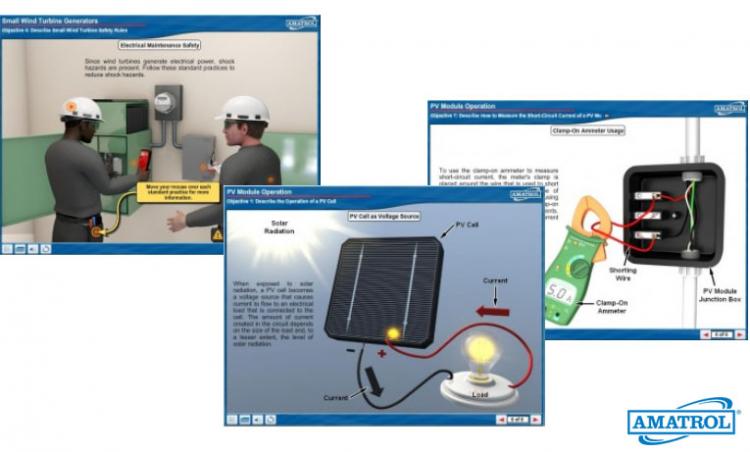 Amatrol’s unmatched multimedia utilizes text, audio, and stunning 3D animations that engage learners in both theoretical knowledge and hands-on skills. This thorough, exceptionally detailed curriculum is built to begin with the basics and steadily advance to more complex concepts and skills. Through partnerships with key industry leaders and leading-edge educators, Amatrol developed the right balance of knowledge and applied skills needed to train learners to work in their chosen field.
Amatrol’s unmatched multimedia utilizes text, audio, and stunning 3D animations that engage learners in both theoretical knowledge and hands-on skills. This thorough, exceptionally detailed curriculum is built to begin with the basics and steadily advance to more complex concepts and skills. Through partnerships with key industry leaders and leading-edge educators, Amatrol developed the right balance of knowledge and applied skills needed to train learners to work in their chosen field.
Student Reference Guide
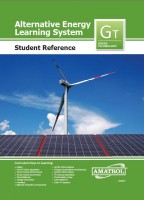 A sample copy of this course’s Student Reference Guide is included with the learning system. Sourced from the multimedia curriculum, the Student Reference Guide takes the entire series’ technical content contained in the learning objectives and combines them into one perfect-bound book. If you would like to inquire about purchasing additional Student Reference Guides for your program, contact your local Amatrol Representative for more information.
A sample copy of this course’s Student Reference Guide is included with the learning system. Sourced from the multimedia curriculum, the Student Reference Guide takes the entire series’ technical content contained in the learning objectives and combines them into one perfect-bound book. If you would like to inquire about purchasing additional Student Reference Guides for your program, contact your local Amatrol Representative for more information.
Product Options
Grid Interactive and Data Acquisition Options
 Amatrol’s 850-AEC Learning System for wind and solar offers a number of options that can greatly expand the capability of the system. The 85-GT1 Grid-Tie Learning System – Solar features a single-phase inverter that enables the system to connect to the classroom grid, typical of PV systems being installed today.
Amatrol’s 850-AEC Learning System for wind and solar offers a number of options that can greatly expand the capability of the system. The 85-GT1 Grid-Tie Learning System – Solar features a single-phase inverter that enables the system to connect to the classroom grid, typical of PV systems being installed today.
The 85-ADA1 Data Acquisition Learning System – Wind and Solar features a multi-point data acquisition module, PC software, and sensors that monitor voltage and current in various parts of both wind and solar circuits, enabling students to study operation via data analysis. Both options are panel-mounted units that easily add to 850 workstations.
Additional Options
- Solar Concepts Learning System (950-SC1)
- Wind Concepts Learning System (950-WC1)
- Alternative Energy Multimedia (M20027)
- Wind Concepts Multimedia (M20011)
- Solar PV Interface (20097)
- Wind Turbine Interface (20099)
Alternative Energy Multimedia (M20027)
This course engages the learner in small wind and solar technologies. PV Module Operation and Performance, Photovoltaic Arrays, Solar Batteries, Solar Battery Charging, Solar PV Systems, Small Wind Turbine Generators, Wind Turbine Batteries, Battery Charging, and Small Wind Systems are some of the topics covered in this course.
Engaging Multimedia
Amatrol’s extensive, thorough multimedia covers green energy themes such as alternative energy. Interactive screens paired with instructive graphics teach an array of alternative energy topics from PV module operation to DC wind turbine systems. With the optional hardware, learners can then apply this theoretical knowledge to immediate hands-on skills. For example, learners study inverters and the operations of PV systems and then manually connect and operate a stand-alone AC PV system for applied practice. This combination of theory and practice ingrains concepts in a learner’s mind and makes more advanced topics easier to comprehend. (References 850-AEC)
Key Features
- Strong Depth and Breadth of Content
- Engaging Interactions
- Stunning 3D Animations
- Text and Audio
- Built for Self-Paced Learning
Learning Topics
- Safety
- Solar Panel Operation
- Solar Panel Performance
- PV Array Connection
- Wind Turbine Operation
- Wind Turbine Performance
- Wind Turbine Connection
- Solar/Wind Batteries
- Charge Controllers
- Inverters
- Balance of System Components
- AC/DC Solar Systems
- AC/DC Wind Systems
- Energy Conservation and Demand
- System Performance
Solar Concepts Learning System (950-SC1)
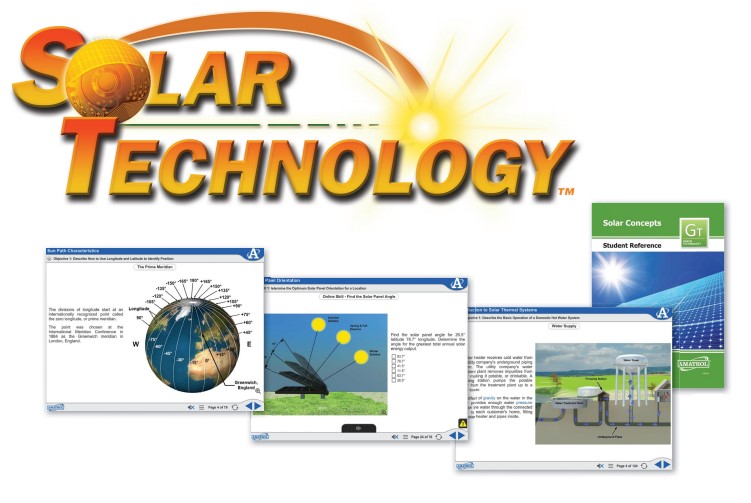 Solar energy is being used in a broad range of applications across industry and residences alike. From heating water for home use to creating utility-scale electricity – solar energy application is growing. Understanding the basics of how we can harness solar energy is essential for technicians, engineers, installers, designers, builders, and others who want to apply solar technology either professionally or personally.
Solar energy is being used in a broad range of applications across industry and residences alike. From heating water for home use to creating utility-scale electricity – solar energy application is growing. Understanding the basics of how we can harness solar energy is essential for technicians, engineers, installers, designers, builders, and others who want to apply solar technology either professionally or personally.
Amatrol’s 950-SC1 Solar Concepts Learning System introduces students to a broad range of basic concepts in solar energy and technology. Photovoltaic and thermal solar systems are introduced to students. They learn how to translate location, sun, and technology into practical applications. The 950-SC1 acts as a foundation for students in solar technology. Solar Concepts includes student curriculum in PC based, interactive multimedia format as well as an instructor’s assessment guide.
Interactive, Engaging Multimedia
Amatrol’s interactive multimedia provides an engaging, stimulating experience for students. The Solar Concepts Learning System includes interactive computer-based instruction with both theory and hands-on tutorials consisting of text, digital video, voice, online self-review tests, interactive simulations, color diagrams and color photos. Amatrol’s strong interactive multimedia includes visual, auditory, and text based learning styles to reinforce each other in well organized learning segments.
Using Solar Technology to Capture Solar Energy - Location Makes a Difference!
Siting a solar array or understanding how much energy you can capture from an array in a specific location requires background provided by Amatrol’s Solar Concepts. The type of application also plays a strong role. With the 950-SC1, students learn how to site an array with optimum orientation as well as determine the insolation, which varies significantly from place to place.
Optional 95-SIP1 Solar Instruments Package
The 950-SC1 Solar Concepts Learning System teaches students to use a variety of instruments required to apply solar technology. These virtually developed skills can be reinforced with hands-on application through the optional 95-SIP1 Solar Instruments Package. The package contains a pyranometer, global positioning system (GPS), inclinometer and compass. Students will learn how to translate their virtual skills to the actual instruments and apply them to solar technology systems. All of these are required to properly orient arrays.
Student Reference Guide
A sample copy of this course’s Student Reference Guide is included with the learning system. Sourced from the multimedia curriculum, the Student Reference Guide takes the entire series’ technical content contained in the learning objectives and combines them into one perfect-bound book. If you would like to inquire about purchasing additional Student Reference Guides for your program, contact your local Amatrol Representative for more information.
Learning Topics
- Insolation Data
- Array Orientation
- Sun Path
- Solar Time
- Global Positioning
- Peak Sun
- Solar Irradiance
- Space Heating & Cooling
- Passive & Active Water Heating
- Solar Industry
- AC & DC Photovoltaic Systems
- Solar Energy Systems
Key Features
- Interactive, Engaging Multimedia
- Using Solar Technology to Capture Solar Energy
- Optional 95-SIP1 Solar Instruments Package
Wind Concepts Learning System (950-WC1)
Wind energy is a significant source of power whose use is growing dramatically. The Department of Energy has set a goal for 20% of electrical energy used in the United States to be from wind power by 2030. Wind farms can be found throughout the world – from cold, arctic conditions to the tropics, from beaches to mountains to oceans. Understanding the basics of how we can harness wind energy is essential for technicians, engineers, installers, designers, builders, and others who want to apply wind technology either in large utility-scale turbine farms or in small wind applications.
Amatrol’s 950-WC1 Wind Concepts Learning System introduces students to a broad range of basic concepts in wind energy technology. Students learn how wind power systems work and what it takes to generate electrical power with wind. The 950-WC1 acts as a foundation for students enrolled in wind-specific as well as general renewable energy programs. Wind Concepts includes student curriculum in PC-based, interactive multimedia format as well as an instructor’s assessment guide.
Using Wind Technology to Capture Wind Energy
Siting a wind farm or turbine is important. With utility-scale wind turbines costing several million dollars, understanding how much energy you can produce from the turbine in a specific location is key. The amount of wind available at different heights varies tremendously as you can see from the wind resource map at right. In the 950-WC1, students gain knowledge and skills in applying science and mathematical skills. Amatrol’s Wind Concepts teaches students about many of the factors involved in the critical turbine siting decision.
The Many Types of Wind Power Systems
Wind power is harnessed by a broad array of wind power systems. The most striking difference is between residential or small wind and utility-scale turbines. While each have their place in the energy landscape, they are very different in both application and design. Understanding the fundamentals of these various systems and how they are used is a good base from which to launch a strong knowledge of wind power. Amatrol’s 950-WC1 Wind Concepts teaches students about the range of wind power systems and how they are applied.
Multimedia Curriculum
Amatrol’s unmatched multimedia utilizes text, audio, and stunning 3D animations that engage learners in both theoretical knowledge and hands-on skills. This thorough, exceptionally detailed curriculum is built to begin with the basics and steadily advance to more complex concepts and skills. Through partnerships with key industry leaders and leading-edge educators, Amatrol developed the right balance of knowledge and applied skills needed to train learners to work in their chosen field.
Student Reference Guide
A sample copy of this course’s Student Reference Guide is included with the learning system. Sourced from the multimedia curriculum, the Student Reference Guide takes the entire series’ technical content contained in the learning objectives and combines them into one perfect-bound book. If you would like to inquire about purchasing additional Student Reference Guides for your program, contact your local Amatrol Representative for more information.
Learning Topics
- Wind Resources
- Wind Resource Measurement
- Wind Power Systems
- Utility-Scale Wind Power Systems
- Wind Power Industry
- Small Wind Power Systems
- Wind Turbine Aerodynamics
- Wind Power Characteristics
- Wind Turbine Ratings
- Wind Turbine Capacity & Availability
- Wind Plant Siting
- Wind Plant Economics
Key Features
- Interactive, Engaging Multimedia
- Types of Wind Power Systems
- Wind Technology to Capture Wind Energy
Wind Concepts Multimedia (M20011)
Wind Concepts introduces wind energy as an important source of power that is growing dramatically. Wind farms can be found in virtually all areas – from cold, arctic conditions to the tropics. Wind Concepts provides learners an understanding of the basics of how we can harness wind energy, either in large utility-scale turbine farms or in small wind applications. Provides an overview of a broad range of basic concepts in wind energy and technology including how wind power systems work and what it takes to generate power with wind technology.
Engaging Multimedia
Amatrol’s extensive, thorough multimedia covers green energy basics such as wind concepts. Interactive screens paired with instructive graphics teach wind concepts topics from wind power systems to wind turbine siting. Learners can then apply this theoretical knowledge to immediate hands-on skills. For example, learners study wind power characteristics and then on their own calculate the wind turbine power given meteorological conditions for applied practice. This combination of theory and practice ingrains concepts in a learner’s mind and makes more advanced topics easier to comprehend. (References 950-WC1)
Learning Topics
- Wind Resources
- Wind Resource Measurement
- Wind Power Systems
- Utility-Scale Wind Power Systems
- Wind Power Industry
- Small Wind Power Systems
- Wind Turbine Aerodynamics
- Wind Power Characteristics
- Wind Turbine Ratings
- Wind Turbine Capacity & Availability
- Wind Plant Siting
- Wind Plant Economics
Key Features
- Strong Depth and Breadth of Content
- Engaging Interactions
- Stunning 3D Animations
- Text and Audio
- Built for Self-Paced Learning
Are Alternative Energy Certifications Important?
Many employers prefer workers who are certified in alternative energy technologies because industry-standard certifications provide evidence that workers have the skills employers need. Amatrol’s Alternative Energy Learning System – Wind and Solar provides foundational training that will help students and workers prepare for portions of the solar and small wind certifications offered by such certifying groups as NABCEP (North American Board of Certified Energy Practitioners), SWCC (Small Wind Certification Council), and ETA (Electronics Technicians Association).
Key Features
- Convenient Indoor / Outdoor Use
- eLearning Curriculum + Real World Components
- Multiple Panel Array and Modern Communications
- Grid-Tie and Data Acquisition Options
Learning Topics
- Safety
- Solar Panel Operation
- Solar Panel Performance
- PV Array Connection
- Wind Turbine Operation
- Wind Turbine Performance
- Wind Turbine Connection
- Solar/Wind Batteries
- Charge Controllers
- Inverters
- Balance of System Components
- AC/DC Solar Systems
- AC/DC Wind Systems
- Energy Conservation and Demand
- System Performance
Solar PV Sun Simulator Training
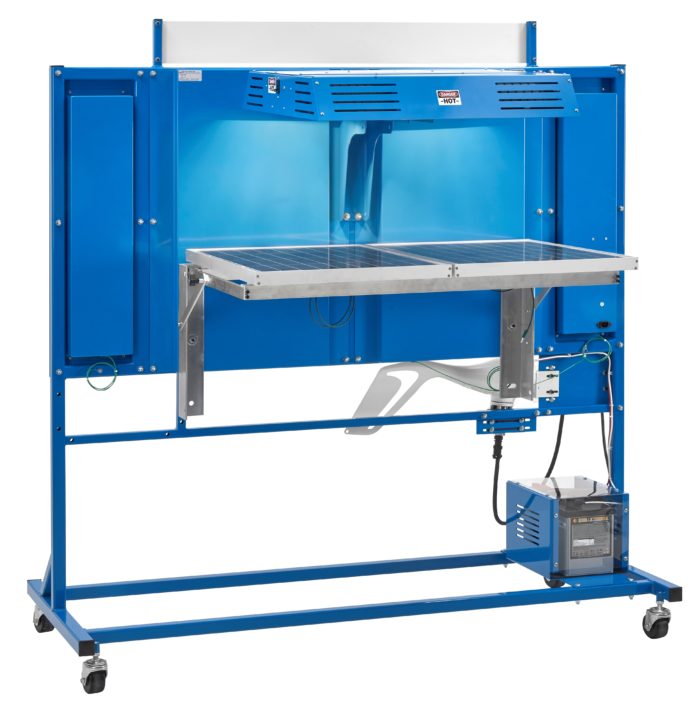 Model Number: 85-SPS1
Model Number: 85-SPS1
Solar PV Sun Simulator Allows Use Indoors
The Solar PV Sun Simulator training system can be added onto the Alternative Energy Learning System – Wind and Solar (850-AEC), Alternative Energy Learning System – Solar (850-AES), or Solar Energy Learning System (85-SE). The Solar PV Sun Simulator training system includes a sun simulator light set, power cable and on/off switch, and mounting system.
The required Solar PV Array Station (85-SPA1) easily disconnects from the workstation to be used outdoors. Indoors, the solar panel array works in conjunction with the required Solar PV Sun Simulator – Alternative Energy (85-SPS1), which uses artificial lights to simulate sunlight. The 850-AEC can also be connected to client-supplied wind turbines or roof-top solar panels with the addition of optional interface connections.
Optional: Grid-Tie Solar Learning System
Model Number: 85-GT1
 The demand for qualified solar technicians is rising, as more consumers and businesses apply grid-tie solar energy systems in their communities, and employers prefer technician candidates who are certified.
The demand for qualified solar technicians is rising, as more consumers and businesses apply grid-tie solar energy systems in their communities, and employers prefer technician candidates who are certified.
The Grid-Tie Learning System – Solar (85-GT1) features real-world components that are commonly found in commercial and residential environments to help make learners job-ready and prepares them for certifications. For example, the 85-GT1 is equipped with a Photovoltaic Combiner box and a multiple panel solar array, allowing learners to connect panels in series and parallel; an Iskra ME162 single-phase meter that measures and registers electric energy in single-phase two-wire networks using globally-recognized products; and an Enphase Solar Microinverter that helps students understand converting DC generated by a single solar module to AC.
The 85-GT1 Grid-Tie Learning System – Solar is an expansion system that can greatly expand the capability of the 850-Alternative Energy Learning Systems (850-AEC or 850-AES). It features a single-phase inverter that enables the system to connect to the classroom grid, typical of PV systems being installed today. Featuring an interactive multimedia curriculum and a student reference guide, the 85-GT1 covers critical skill areas like inverters, system codes and standards, and system operation.
What are Grid-Tie PV Systems? How do they work?
A grid-connected, or grid-tie, photovoltaic system connects to and interacts with the utility grid. The type of system provides power to loads from both the PV array and the grid. Grid-tie systems also have the ability to supply power back to the grid when the PV array generates more power than the loads require.
Grid-tie systems use an interactive-type inverter to connect to and interact with, the grid. Often, these systems do not have battery backup. Instead, the inverter converts DC power directly from the PV array into AC power at the required voltage and frequency to match the grid. The output of an interactive inverter provides AC power to the loads during daylight hours. Any excess power generated is supplied to the utility grid for use somewhere else. During nighttime hours or low light conditions, the utility grid provides all the power to the loads.
Learning Topics
- Grid-Tie Inverters
- System Codes and Standard
- System Operation
- Inverter Stacking
- Micro Inverter Monitoring Device
- Interconnection Codes
- Net Metering
Key Features
- Covers skills used in industrial, commercial, agricultural, and residential applications
- Features industrial components
- Interactive Multimedia to Engage the Learner
- Durable and Efficient
- Student Reference Guide
Product Options
Additional Requirements
- Adds to 850-AEC or 850-AES
- Computer: See requirements
- Electricity (220V/60 Hz/1ph)
Multimedia Curriculum
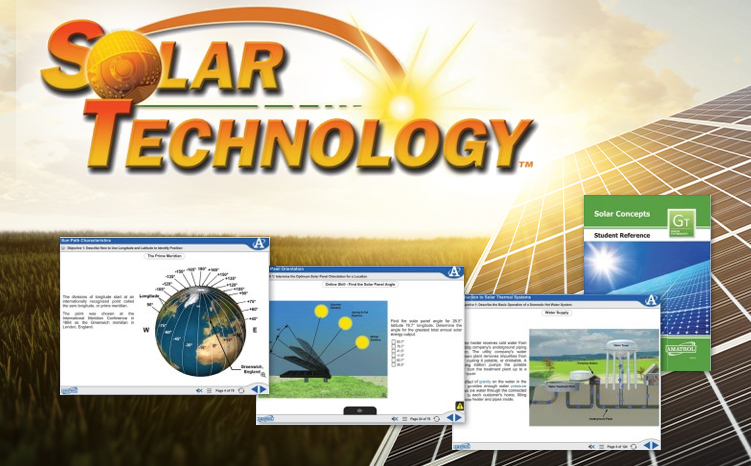
Solar Concepts (950-SC1)
Introduces learners to a broad range of basic concepts in solar energy and technology. Photovoltaic and thermal solar systems are introduced to students. They learn how to translate location, sun, and technology into practical applications. The Solar Concepts training acts as a foundation for students in solar technology.
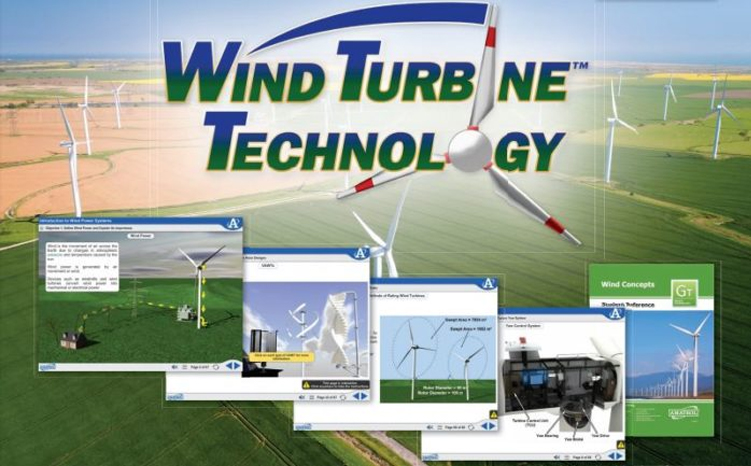
Wind Concepts (950-WC1)
Introduces learners to a broad range of basic concepts in wind energy technology. Learners study how wind power systems work and what it takes to generate electrical power with wind. Wind Concepts training acts as a foundation for learners enrolled in wind-specific as well as general renewable energy programs.

